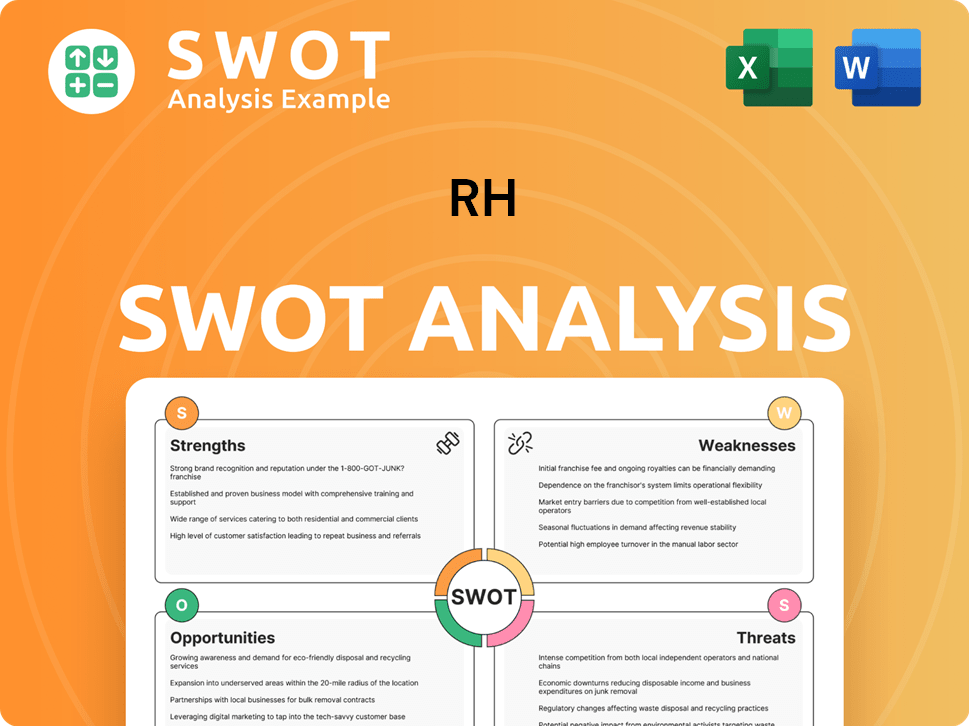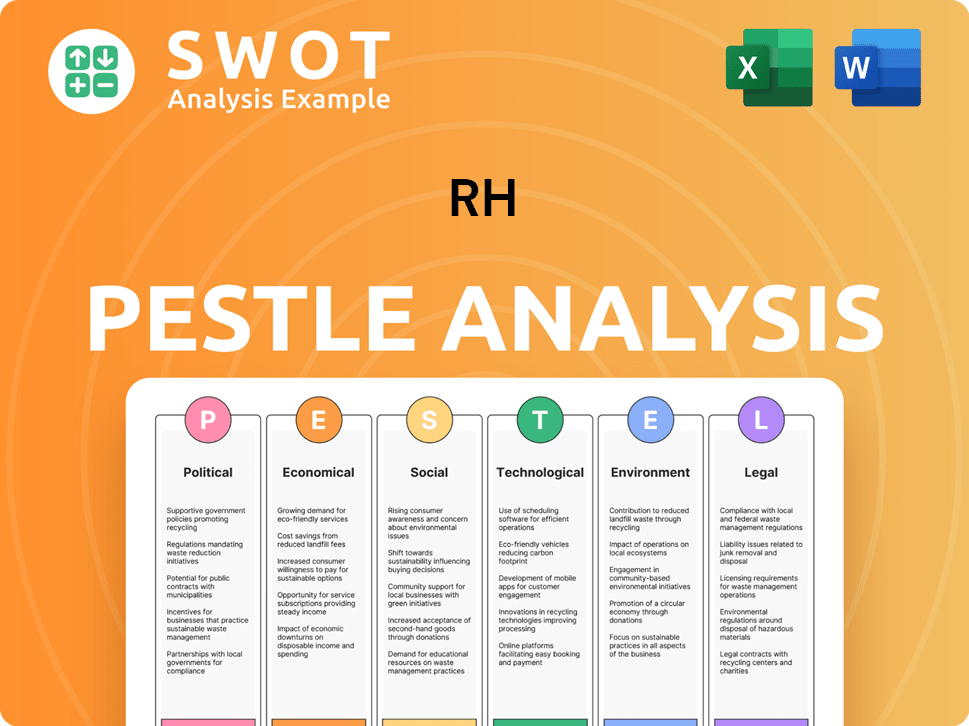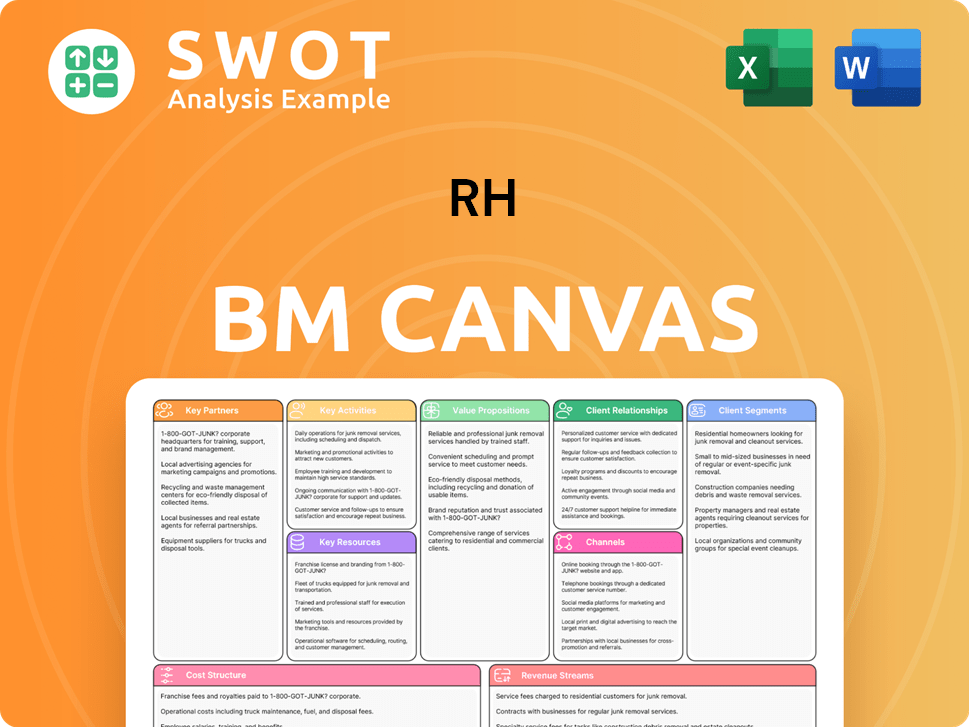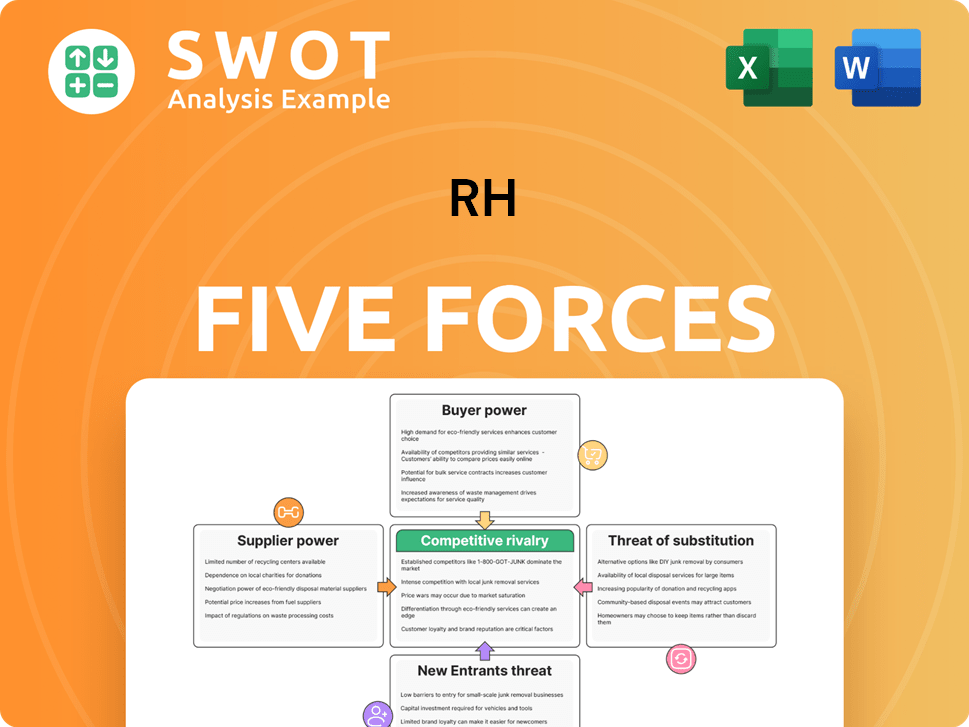RH Bundle
How Does RH Dominate the Luxury Home Furnishings Market?
RH, formerly known as Restoration Hardware, has carved a unique niche in the luxury home furnishings sector. From its inception in 1979, the company has evolved from a hardware supplier to a purveyor of aspirational living, captivating consumers with its commitment to design and quality. This transformation has positioned RH as a key player, but how does it navigate the RH SWOT Analysis and compete in a dynamic environment?

This exploration delves into the RH competitive landscape, analyzing its key RH competitors and dissecting its RH business strategy. We'll examine RH market analysis to understand its strengths, weaknesses, opportunities, and threats, while also scrutinizing its financial performance relative to rivals in the luxury home furnishings industry. Understanding Restoration Hardware's approach provides valuable insights for investors and business strategists alike.
Where Does RH’ Stand in the Current Market?
RH occupies a distinctive market position within the luxury home furnishings sector. It differentiates itself from conventional retailers by focusing on high-end design, quality craftsmanship, and a curated aesthetic. This positioning allows it to target affluent customers who value premium products and experiences. For a deeper understanding of the company's origins, consider reading a brief history of RH.
The company's core operations revolve around designing, sourcing, and selling a wide range of home furnishings. These include furniture, lighting, textiles, rugs, bathware, décor, and outdoor and garden products. RH presents these products through a consistent luxury narrative, both in its physical galleries and online platforms. This approach aims to create a cohesive brand experience that resonates with its target demographic.
RH's value proposition centers on offering a premium lifestyle experience. This involves not only high-quality products but also exceptional customer service, innovative gallery designs, and design services. The company aims to provide a complete solution for its customers' home furnishing needs, solidifying its position as a leading player in the luxury market.
While specific market share data for the ultra-luxury segment is often proprietary, RH's financial results highlight its strong market presence. In fiscal year 2023, RH reported net revenues of $3.03 billion, demonstrating its resilience in a challenging market. This financial performance underscores its ability to maintain a significant share within its niche.
RH primarily targets affluent customers who seek high-end design and quality. Its product lines encompass furniture, lighting, textiles, rugs, bathware, décor, and outdoor and garden products. The company's focus on luxury and design allows it to cater to a specific demographic, differentiating it from mass-market retailers.
RH's geographic presence is primarily in North America, with a growing emphasis on international expansion. Recent openings like RH England, The Gallery at the Historic Aynho Park, signify a strategic move towards a global luxury lifestyle brand. This expansion aims to broaden its market reach and solidify its premium standing.
Despite recent revenue declines from peak pandemic levels, RH's financial health remains robust. The company reported a net income of $133 million in fiscal year 2023. This financial strength, combined with its innovative gallery model and design services, positions RH as a premium player in the luxury home furnishings market.
RH's market position is shaped by its focus on the luxury segment and strategic international expansion. The company faces challenges in the broader home furnishings market, but its premium positioning and growth initiatives aim to maintain its leadership. Understanding the RH competitive landscape is crucial for investors and industry analysts.
- RH's focus on the luxury segment insulates it from some of the competitive pressures faced by mass-market retailers.
- International expansion, such as the opening of galleries in the UK, is a key strategy for growth.
- The company's financial performance, including its net income, reflects its ability to navigate market challenges.
- RH's brand positioning emphasizes design, quality, and a curated aesthetic, appealing to affluent consumers.
RH SWOT Analysis
- Complete SWOT Breakdown
- Fully Customizable
- Editable in Excel & Word
- Professional Formatting
- Investor-Ready Format

Who Are the Main Competitors Challenging RH?
The competitive landscape for RH is multifaceted, encompassing both direct and indirect rivals within the luxury home furnishings market. Understanding the RH competitive landscape is crucial for assessing its market position and strategic direction. This analysis considers various players, from high-end furniture brands to broader retail and e-commerce platforms.
RH competitors face challenges and opportunities shaped by consumer preferences, economic trends, and technological advancements. The company's ability to navigate these dynamics is essential for maintaining its competitive edge and driving growth. A thorough RH market analysis is vital for investors and stakeholders.
Direct competition for Restoration Hardware comes from brands that also target the luxury home furnishings market. These competitors often focus on high-quality materials, distinctive designs, and premium customer experiences. They compete for the same affluent customer base that RH seeks to attract.
Arhaus is a direct competitor known for its handcrafted furniture and emphasis on sustainable practices. It appeals to consumers who value both luxury and environmental responsibility. Arhaus's focus on unique designs and ethical sourcing differentiates it in the market.
Williams-Sonoma, Inc., through brands like Pottery Barn and West Elm, offers stylish home furnishings at various price points. These brands cater to design-conscious consumers with a broader range of products and accessible price points compared to RH. Their established brand recognition and extensive retail presence pose a significant competitive challenge.
Specialized luxury furniture brands, such as Baker Furniture and Holly Hunt, target the high-end market with exclusive, high-designer pieces. These brands focus on bespoke solutions and premium materials, catering to a niche clientele. Their emphasis on craftsmanship and design exclusivity provides a competitive edge.
Indirect competition comes from a broader range of players that influence consumer choices and market dynamics. These competitors may not directly offer luxury products but impact the overall home furnishings market.
E-commerce giants like Amazon and Wayfair provide vast selections and competitive pricing, influencing consumer expectations for convenience and speed. While not luxury brands, they impact market dynamics by offering a wide array of home goods. Their scale and efficiency challenge traditional retailers.
Interior design firms and custom furniture makers offer bespoke solutions for discerning clients. They provide personalized services and unique designs, appealing to customers seeking tailored products. Their ability to create customized pieces differentiates them from mass-market retailers.
The rise of DTC brands in the home goods space, often leveraging digital marketing and streamlined supply chains, represents an emerging competitive force. These brands offer competitive pricing and convenient shopping experiences. However, they may not operate at RH's scale or luxury tier.
Mergers and acquisitions within the furniture sector can reshape competitive dynamics. Private equity acquisitions and strategic alliances create larger, more diversified entities. These changes can impact market share and competitive strategies.
RH's business strategy must address several key factors to maintain its market position. These include brand positioning, product innovation, and customer experience. Understanding these elements is crucial for assessing RH's financial performance vs competitors.
- Brand Positioning: RH's luxury positioning requires consistent brand messaging and a focus on high-quality products.
- Product Innovation and Design: The company's ability to introduce new designs and product lines influences its appeal.
- Customer Experience: Providing excellent customer service and a seamless shopping experience is crucial.
- Market Trends: Economic trends and consumer preferences significantly impact the home furnishings market.
- Supply Chain Challenges: Managing supply chains and mitigating disruptions are critical for maintaining product availability.
- Economic Trends: The broader home furnishings market saw a decline in 2023, impacting many players.
For more insights into RH's target demographic, consider reading Target Market of RH.
RH PESTLE Analysis
- Covers All 6 PESTLE Categories
- No Research Needed – Save Hours of Work
- Built by Experts, Trusted by Consultants
- Instant Download, Ready to Use
- 100% Editable, Fully Customizable

What Gives RH a Competitive Edge Over Its Rivals?
The competitive advantages of RH, formerly known as Restoration Hardware, are centered on its strong brand equity and unique market positioning within the luxury home furnishings sector. RH distinguishes itself through an aspirational lifestyle brand, offering more than just furniture. This is achieved through immersive retail experiences and a curated product assortment that emphasizes timeless design and quality craftsmanship. Understanding the Marketing Strategy of RH is crucial to grasping its competitive edge.
RH's strategy revolves around creating a cohesive luxury experience across all customer touchpoints, from its expansive galleries to its integrated e-commerce platform. The company's focus on design leadership and interior design services further enhances customer loyalty. While some advantages, like brand equity, are sustainable, others require continuous innovation and investment to stay ahead of evolving consumer preferences and market trends. The company's ability to manage inventory and logistics for high-value items also contributes to its competitive strength.
RH's competitive landscape involves several key players and strategies. The company competes with both direct and indirect competitors, including other luxury home furnishing retailers, online marketplaces, and high-end furniture brands. RH's success is contingent on maintaining its brand image, adapting to changing consumer behaviors, and effectively managing its supply chain and operational costs. RH's market share analysis in 2024 shows the company's position relative to its competitors.
RH has cultivated a strong brand image associated with luxury and aspirational living. Its galleries serve as immersive brand experiences, differentiating it from competitors. This positioning allows RH to command premium pricing and attract a specific customer demographic.
RH's focus on timeless design, quality craftsmanship, and luxurious materials sets its products apart. The company's 'design leadership' ensures its offerings remain distinct and desirable. This curated approach allows RH to maintain a competitive edge in the luxury home furnishings market.
RH's integrated business model, encompassing retail galleries, source books, and e-commerce, provides multiple touchpoints for customer engagement. This omnichannel approach reinforces its brand narrative and enhances customer convenience. This strategy is vital for RH's business strategy.
RH's ability to manage inventory and logistics for large, high-value items is a significant advantage. While specific details are proprietary, efficient operations contribute to profitability and customer satisfaction. This is a key factor in RH's financial performance vs competitors.
RH's competitive advantages include its strong brand equity, curated product assortment, integrated business model, and operational efficiencies. These factors enable RH to maintain a strong position in the luxury home furnishings market. RH's target market demographics are crucial to its success.
- Brand Strength: A well-established brand recognized for luxury and aspirational living.
- Design Leadership: Focus on timeless design and high-quality craftsmanship.
- Customer Experience: Immersive retail galleries and personalized interior design services.
- Operational Excellence: Efficient supply chain and inventory management.
RH Business Model Canvas
- Complete 9-Block Business Model Canvas
- Effortlessly Communicate Your Business Strategy
- Investor-Ready BMC Format
- 100% Editable and Customizable
- Clear and Structured Layout

What Industry Trends Are Reshaping RH’s Competitive Landscape?
The home furnishings industry is currently experiencing a period of significant change, driven by technological advancements, evolving consumer preferences, and increasing regulatory scrutiny. This dynamic environment presents both opportunities and challenges for companies like RH, demanding strategic adaptation to maintain a competitive position. Understanding the RH competitive landscape requires a keen awareness of these industry trends and their potential impact on the company's future.
In 2023, the housing market faced headwinds, with rising interest rates and a decrease in existing home sales, which affected the furniture industry. Economic uncertainties and inflationary pressures have also influenced consumer spending on discretionary items, posing a challenge to sales growth in the luxury home furnishings sector. However, RH's focus on its 'RH ecosystem' and strategic initiatives aim to mitigate these challenges and foster long-term growth.
Technological advancements are reshaping the retail landscape. Consumers are demanding seamless online experiences, augmented reality (AR) tools, and personalized digital interactions. Regulatory changes, especially in sustainability and supply chain transparency, are gaining importance. Consumer preferences are shifting towards personalized and experiential retail, which RH's gallery model is well-positioned to capitalize on.
Economic uncertainties and inflationary pressures may impact discretionary spending. The broader housing market, with rising interest rates and lower existing home sales, presents headwinds. Staying ahead of digitally native brands in the face of rapid technological change is crucial. Supply chain challenges and the need for sustainable practices require constant attention.
Continued global expansion, especially in untapped luxury markets, offers growth potential. Diversification into adjacent luxury categories, such as hospitality and real estate, presents additional avenues for growth. Strengthening the 'RH ecosystem' to capture a larger share of customer spending is a key strategy. Emphasis on sustainable materials and responsible manufacturing can enhance the brand image.
RH is focused on elevating its brand, expanding its real estate footprint, and controlling its supply chain. The company aims for long-term growth and market leadership in the luxury home furnishings sector. The strategies are designed to navigate economic uncertainties and maintain a strong market position. RH is investing in innovation and customer experience.
RH's success will depend on its ability to adapt to evolving industry trends and address future challenges. The company must leverage opportunities for growth while mitigating risks. Key areas of focus include technological innovation, sustainable practices, and customer experience.
- Market Analysis: Understanding the RH market analysis is critical for strategic decisions.
- Competitive Advantages: Identifying RH competitive advantages and disadvantages will help to refine strategies.
- Financial Performance: Monitoring RH's financial performance vs competitors is essential for assessing its market position.
- Brand Positioning: Maintaining a strong RH's brand positioning in the market is vital for attracting and retaining customers.
RH Porter's Five Forces Analysis
- Covers All 5 Competitive Forces in Detail
- Structured for Consultants, Students, and Founders
- 100% Editable in Microsoft Word & Excel
- Instant Digital Download – Use Immediately
- Compatible with Mac & PC – Fully Unlocked

Related Blogs
- What are Mission Vision & Core Values of RH Company?
- What is Growth Strategy and Future Prospects of RH Company?
- How Does RH Company Work?
- What is Sales and Marketing Strategy of RH Company?
- What is Brief History of RH Company?
- Who Owns RH Company?
- What is Customer Demographics and Target Market of RH Company?
Disclaimer
All information, articles, and product details provided on this website are for general informational and educational purposes only. We do not claim any ownership over, nor do we intend to infringe upon, any trademarks, copyrights, logos, brand names, or other intellectual property mentioned or depicted on this site. Such intellectual property remains the property of its respective owners, and any references here are made solely for identification or informational purposes, without implying any affiliation, endorsement, or partnership.
We make no representations or warranties, express or implied, regarding the accuracy, completeness, or suitability of any content or products presented. Nothing on this website should be construed as legal, tax, investment, financial, medical, or other professional advice. In addition, no part of this site—including articles or product references—constitutes a solicitation, recommendation, endorsement, advertisement, or offer to buy or sell any securities, franchises, or other financial instruments, particularly in jurisdictions where such activity would be unlawful.
All content is of a general nature and may not address the specific circumstances of any individual or entity. It is not a substitute for professional advice or services. Any actions you take based on the information provided here are strictly at your own risk. You accept full responsibility for any decisions or outcomes arising from your use of this website and agree to release us from any liability in connection with your use of, or reliance upon, the content or products found herein.